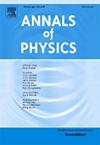具有热力学一致的EoS和部分可变形强子的HRG中的粒子产生
IF 3
3区 物理与天体物理
Q2 PHYSICS, MULTIDISCIPLINARY
引用次数: 0
摘要
在本工作中,我们分析了在大范围的质心碰撞能量(sNN)范围内的超相对论重离子碰撞(URHIC)实验中获得的几种奇异和非奇异相对强子产额。我们提出在URHIC之后的最后阶段形成热而致密的强子共振气体(HRG)。我们使用先前提出的热力学一致性方法来获得HRG的状态方程(EoS)。它考虑了强子相互作用的一个重要方面,即强子的硬核斥力,通过将硬核体积分配给强子,导致排除体积(EV)型效应。我们使用袋模型方法将硬核体积分配给重子(反重子),同时将介子视为点粒子。我们用ansatz方法得到了HRG体系的温度(T)和重子化学势(BCP)与URHIC质心能的关系。我们还发现了双重冻结情景的有力证据,分别对应于重子(反重子)和介子。奇异性(反奇异性)不平衡因子在解释奇异强子与非奇异强子的比例上也起着重要的作用。利用最小χ2/dof方法,利用一组模型参数获得了与实验数据的最佳理论拟合,可以较好地解释从最低RHIC能量到最高LHC能量的大范围sNN内各种相对强子多重度的实验数据。本文章由计算机程序翻译,如有差异,请以英文原文为准。
Particle production in HRG with thermodynamically consistent EoS and partially deformable hadrons
In the present work, we analyze several strange as well as non-strange relative hadronic yields obtained in the ultra-relativistic heavy-ion collisions (URHIC) experiments over a wide range of center-of-mass collision energy (). We invoke the formation of a hot and dense hadronic resonance gas (HRG) in the final stage following the URHIC. We use an earlier proposed thermodynamically consistent approach for obtaining the equation of state (EoS) of a HRG. It takes into account an important aspect of the hadronic interaction, viz., the hadronic hard-core repulsion, by assigning hard-core volumes to the hadrons, leading to an excluded volume (EV) type effect. We have invoked the bag model approach to assign hard-core volumes to baryons (antibaryons) while treating mesons to be point particles. We employ ansatz to obtain the dependence of the temperature (T) and baryon chemical potential (BCP) of HRG system on the center-of-mass energy in URHIC. We also find strong evidence of a double freeze-out scenario, corresponding to baryons (antibaryons) and mesons, respectively. Strangeness (anti-strangeness) imbalance factor is also seen to play an important role in explaining the ratio of strange hadrons to the non-strange ones. The HRG model can explain the experimental data on various relative hadronic multiplicities quite satisfactorily over a wide range of , ranging from the lowest RHIC energies to the highest LHC energies using one set of model parameters by obtaining the best theoretical fits to the experimental data using the minimum /dof method.
求助全文
通过发布文献求助,成功后即可免费获取论文全文。
去求助
来源期刊

Annals of Physics
物理-物理:综合
CiteScore
5.30
自引率
3.30%
发文量
211
审稿时长
47 days
期刊介绍:
Annals of Physics presents original work in all areas of basic theoretic physics research. Ideas are developed and fully explored, and thorough treatment is given to first principles and ultimate applications. Annals of Physics emphasizes clarity and intelligibility in the articles it publishes, thus making them as accessible as possible. Readers familiar with recent developments in the field are provided with sufficient detail and background to follow the arguments and understand their significance.
The Editors of the journal cover all fields of theoretical physics. Articles published in the journal are typically longer than 20 pages.
 求助内容:
求助内容: 应助结果提醒方式:
应助结果提醒方式:


